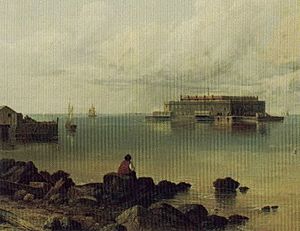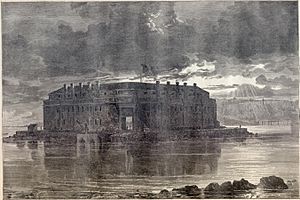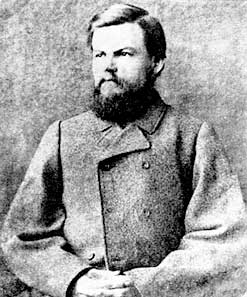Fort Lafayette facts for kids
Quick facts for kids Fort Lafayette |
|
|---|---|
| Hendricks Reef, offshore of New York City borough of Brooklyn, New York | |

Fort Lafayette, seen from the Brooklyn shore with Denyse's Wharf to the left
|
|
| Coordinates | 40°36′30″N 74°02′19″W / 40.60833°N 74.03861°W |
| Site history | |
| Built | 1815-1822 |
| Built by | United States Army Corps of Engineers |
| In use | 1822-1946 (ammunition storage after 1897) |
| Materials | sandstone, brick |
| Fate | demolished 1960 |
Fort Lafayette was an old island fort in New York Harbor. It was built on a natural island called Hendrick's Reef. This island was just off the coast of Brooklyn, near Fort Hamilton.
Building the fort started during the War of 1812. It was finished in 1822. The fort was first named Fort Diamond because of its shape. In 1823, it was renamed to honor the Marquis de La Fayette. He was a French hero who helped America in the American Revolution. The fort was torn down in 1960. This was to make space for the Verrazano-Narrows Bridge. The Brooklyn tower of the bridge now stands where the fort used to be.
Contents
Building Fort Lafayette
Fort Lafayette was shaped like a diamond. This is why it was first called Fort Diamond. It had about 72 cannons. These cannons were placed on three levels. Two levels were in protected rooms called casemates. The top level had cannons on the roof.
This design allowed many cannons to fire at enemy ships. They could aim at ships entering the Narrows. The fort was made of sandstone and brick. However, it could be attacked from the Brooklyn shore. So, Fort Hamilton was built around 1830 to protect it. In the 1840s, Robert E. Lee worked on fixing and improving the fort. He was a captain in the United States Army Corps of Engineers at the time.
Fort Lafayette During the Civil War
Before 1861, the fort's cannons guarded the harbor. But during the American Civil War, Fort Lafayette was used differently. It became a prison for Confederate soldiers. It also held politicians who disagreed with President Abraham Lincoln's actions. These people were held without a formal trial. Because of this, some people called Fort Lafayette the "American Bastille."
Notable Prisoners
- Robert Cobb Kennedy: He was a former captain in the Confederate army. He was part of a plan to set fires in New York City on Thanksgiving Day in 1864. This was meant as revenge for General Sherman burning Atlanta. Kennedy was the only one caught. He was held at Fort Lafayette, tried by a military court, and executed there in 1865.
- Francis Key Howard: He was the grandson of Francis Scott Key, who wrote "The Star-Spangled Banner." Howard was a newspaper editor in Baltimore. His newspaper supported the Southern cause. He was arrested in 1861 by order of General George B. McClellan. This happened because he wrote an article criticizing President Lincoln. The article was about Lincoln's decision to suspend certain legal rights. Howard was first sent to Fort Lafayette. Later, he was moved to Fort Warren in Boston.
Later Uses and Demolition
A big fire damaged Fort Lafayette in 1868. It was rebuilt afterward. In 1883, Edmund Zalinski used the fort for experiments. He was testing his new dynamite gun. This special gun was briefly used by both the US Army and Navy.
From 1898 to 1946, the US Navy used the fort. It was a place to store and move ammunition. Fort Lafayette was torn down in 1960. Its island location was needed for the base of the Brooklyn tower of the Verrazano-Narrows Bridge.
Images for kids







